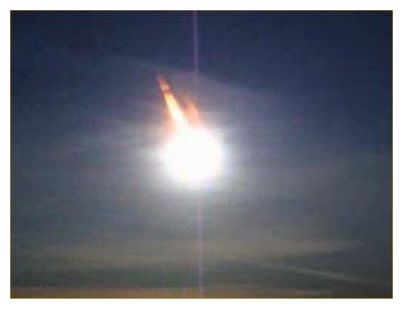
Early indications pointed to the likelihood it could even have been normal meteors brightening up the night sky. The phenomenon occurred on Friday around 10.30pm local time in the state. In some places in Ernakulam district, a few residents even alerted the police and fire and rescue personnel.
Social media, too, got into the act, with people posting their experiences of witnessing the aerial spectacle accompanied by a booming sound. Some of those who experienced it even mistook it for an earthquake. One person tweeted that a ball of fire had fallen over Kochi.
Some people in the state's commercial capital, Kochi said they felt mild tremors after witnessing a luminous object falling from the sky. Interestingly, the phenomenon seemed to be visible right to the southern end of the state. Sightings of the light in the sky were also reported from the northern districts of Malappuram, Palakkad and Kozhikode.
Some have speculated that the pieces that fell from the sky could be rocket debris that re-entered the earth's atmosphere. However, no special activity appears to have been spotted by the radars. Ernakulam district collector M.G. Rajamanickam said no clues had been received for any apparent earthquake.
The meteorological department is making an assessment of the phenomenon, and early indications are that the phenomenon has no link to any climate change issue.
Meanwhile, a suspected depression or an impact crater, believed to be caused by a 'fireball spotted last night in several districts of southern Indian state of Kerala, has been located in Karimalloor village in Ernakulam district on Saturday.
A team of the State Disaster Management Authority is on their way to the spot, official scientist from the authority, Sekhar Kuriakose said here.
"We have located a suspected impact crater at Karimalloor village in Ernakulam district and our team is rushing to the spot," he said.
It is yet to be ascertained as to what exactly caused the phenomena, but there is a possibility that the crater might be caused by a meteor, he said.
A huge 'fireball' was noticed streaking across the sky last night in parts of Thrissur, Ernakulam, Palakaad, Kozhikode and Malappuram districts of Kerala.
An area in the village, where the crater was noticed, was found charred, he said adding more details are expected after the officials visit the site.
However, authority dismissed speculations that the 'fireball' could be celestial debris, as the consortium of space agencies closely monitor any space related activities and would have notified the management of any such appearance.
Kuriakose even dismissed the 'object' as anything related to 'metal' as Air Traffic Control radar system would have recorded it.
Meanwhile, science author and cosmology researcher, Rajagopal Kamath, said that the 'fireball' could be "a rocket or satellite debris. It also could be stony chondrite meteorites as in many places people have claimed that they have seen a bluish flame, which is peculiar to any meteorites."
The locals said they felt tremors and witnessed sounds with the passing of the 'object'.
"We saw a fireball like a meteor. Initially, we thought someone had burst a cracker. The doors and windows started shaking. Some thought there was an explosion somewhere," a local hailing from Kochi said.




OK. It is now the first of March and about the earliest date I would expect Itys, the black headed meteor, to return to Earth for its currently four yearly visit - approx. Please keep an eye on the sky for the next few months especially between the hours 7.30pm to 8.30 pm local time. As the orbit decays on each passage through the atmosphere my best guess for the next appearance is about May but it could be later or earlier by perhaps three months..
I first saw Itys in about the first week in November 1985. This was is very likely the first pass as the mega asteroid appeared at close to midnight on its SSE to NNW path. It must always track in this direction.
To identify Itys: Firstly Itys is very much larger than a typical fireball although the speed is typical. Itys travels at around 37,000 miles per hour although this is slowing on each pass.
Typically the head appears dark against the sky but the front and sides are fringed with ruddy orange flame. There may be plasma (flame) whipping around the sides. On the early passes (night time) this would illuminate the ground with a flickering light with a bandwidth of a few Hz. I do not expect another fully nocturnal visit and indeed when Itys comes in prior to about 6:00 pm local time and if you see it you are at (or close to) ground zero. That is the best place to be, but you will not have time to realise this.
The fact that the head is dark allows the size of Itys to be estimated fairly well. I did this in 1985 when Itys travelled close to overhead and was the size of a small fist but silent. The darkness means the angular size is a true angular size. Incandescent fireballs produce huge amounts of scattered light which greatly exagerate the size of the head. Itys at the time must have been in a height range of 50+/-25 miles giving a diameter of about 5.6km (3.5 miles) at 50 miles. Itys is slightly ovoid with an aspect ratio of about 1.2:1 with little if any rotation.
When Itys visited in 2003 it was accompanied by thunderous noise - a continually rolling thunder that shook houses for many miles around its track. One witness reported its presence lasting only 1-2 seconds. This tallies with the low altitude. He and his friend were both terrified as the whole surroundings lit with this ruddy light. My probing questions upset him rather. I suggested it might be a "fragment" but he shouted down the phone: "It was a giant space rock". I knew this but didn't want the realisation. The horror of the implication was almost too much for me.
The last two visits have seen Itys at much higher altitudes than the 2003 visit. My suspicion is the orbit was perturbed by the moon resulting in Itys surfing along the troposphere. While the energy lost during this pass has resulted in a much shorter orbital period (Itys is NOT in a two body orbit) the altitude seems to have been restored to about that of the 1985 pass. It is to be hoped that the next visit does not coincide with a new moon or even a first and last sliver. If not we have at least another four years to engage in human stupidity.
If Itys has a significant tail this will be typically dark for many degrees of azimuth behind the head but will likely flame into incandescence beyond that point.
If you survive, let us know.